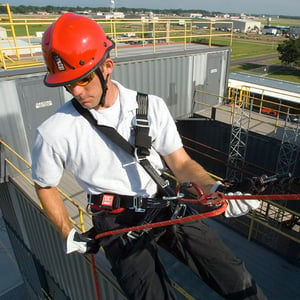Because it is important to keep our readers and students updated, we wanted to share the following information with you. Please note that this issue is not resolved as of this time, and we have a letter submitted to OSHA for clarification. However, we wanted to keep you in the loop so that you can make better decisions when it comes to your rescue preplanning and operations.
It has recently come to our attention that there is a pending OSHA Letter of Interpretation (LOI) regarding the requirement for an “individual retrieval line” for each entrant. This pending interpretation is different from our understanding of what’s required by the regulation (1910.146). While this particular technique is one option of providing external retrieval, there are other alternatives currently being used by rescuers.As mentioned above, Roco has submitted a detailed letter to OSHA for a clarification, stating our position that the use of individual lines for entrants in all cases is problematic for a number of reasons. Although OSHA’s response in its letter of interpretation is ambiguous as to its applicability to entry rescue operations, in our commitment to follow the intent of all OSHA standards, Roco is assuming that OSHA’s response was intended to apply to all entries, including rescue entries. Therefore, we will teach and use “individual lines” for the time being until we get further clarification from OSHA.
Question to OSHA:
In a request for clarification, a gentleman from Maryland had asked this question, “Does OSHA 1910-146 (k)(3) require that each individual entrant, including workers and/or rescuers, entering into a confined space be provided with an independent retrieval line or can more than one entrant be connected to a single retrieval line?”
OSHA’s Response:
OSHA’s response in the LOI states, “OSHA 1910.146(k)(3)(i) requires that each authorized entrant into a permit-required confined space must have a chest or full-body harness attached to their ‘individual’ retrieval line or life line to ensure immediate rescue of the entrant.”
Roco Note: It is important to note that “individual” retrieval line is not used in (k)(3)(i); it simply refers to “a” retrieval line. The standard states, “Each authorized entrant shall use a chest or full body harness, with a retrieval line attached at the center of the entrant’s back near shoulder level, above the entrant’s head, or at another point….”
Additional Roco Comments:
First of all, OSHA’s Permit-Required Confined Spaces Standard is, for the most part, a “performance-based” standard, meaning that it generally provides a result that is to be met, but leaves the manner by which that result is to be obtained to the judgment of the employer. This is particularly true of the rescue and retrieval requirements, as the specific circumstances and conditions of each entry or rescue will dictate what equipment and techniques may be required. However, this pending Letter of Interpretation (LOI) regarding the use of retrieval lines in Confined Spaces crosses over into the area of specific equipment and techniques that must be used.
Consistent with the performance-based nature of the standard, Roco has taught for years a technique that uses a single retrieval line for multiple entrants as an option to reduce line entanglement hazards during a rescue. The use of this technique was based on testimony given to OSHA prior to the Permit Required Confined Spaces Standard (29CFR 1910.146) being published, and indeed our interpretation of the intent of the standard. The particular technique in question is a common practice for rescuers in which one retrieval line is used and multiple entrant/rescuers are attached at different intervals with butterfly knots to reduce entanglement hazards during a rescue (see example below.)

This pending interpretation would put restraints on techniques used by rescuers when entanglement issues could be a problem. It would result in the management of multiple retrieval lines in the space which could affect the effectiveness of the rescue or result in an increased danger to the entrants and/or rescuers. In effect, this OSHA interpretation could cause an “all or nothing” response regarding the use of retrieval lines for rescuers and entrants. This LOI would eliminate the opportunity of using an external rescue technique for certain situations.
Paragraph (k)(3) allows entrants to forgo using a retrieval line in certain situations –
“To facilitate non-entry rescue, retrieval systems or methods shall be used whenever an authorized entrant enters a permit space, unless the retrieval equipment would increase the overall risk of entry or would not contribute to the rescue of the entrant.”
The technique in question is an option that falls between each individual having an “individual” retrieval line, and having to opt out of using a retrieval line at all, and it allows for external retrieval to still be an option in many cases. And, as most of you know from personal experience, for most confined space portals only one individual can pass through at a time anyway. Even with multiple retrieval lines, it is still a “one at a time” event. A shared retrieval line allows the same to take place.
It is Roco’s position that the rescue and retrieval techniques used in rescue should be performance based to allow for the ever-changing conditions and problems that are unique to rescue. We also feel this pending LOI could affect the safety and ability of rescuers to adjust to these situations. However, until this issue is clarified, Roco will not teach or use the technique of having multiple rescuers/entrants attached to the same retrieval line in consecutive order using midline knots as their attachment points.

 For other situations, if communications with the rescue subject are established in six minutes or less, and it is determined that the victim is relatively unharmed (alert and oriented, good airway and breathing, and no signs of active bleeding) then the urgency is reduced and a more measured approach to the rescue could be employed. There is still the potential for suspension trauma to develop over a range of several minutes, so a “prompt” but measured rescue would still be necessary.
For other situations, if communications with the rescue subject are established in six minutes or less, and it is determined that the victim is relatively unharmed (alert and oriented, good airway and breathing, and no signs of active bleeding) then the urgency is reduced and a more measured approach to the rescue could be employed. There is still the potential for suspension trauma to develop over a range of several minutes, so a “prompt” but measured rescue would still be necessary. Question: If I close and Lockout/Tagout the main valve on the natural gas line supplying a boiler unit – does this satisfy OSHA’s requirement for eliminating the hazard of a permit required confined space?
Question: If I close and Lockout/Tagout the main valve on the natural gas line supplying a boiler unit – does this satisfy OSHA’s requirement for eliminating the hazard of a permit required confined space? ASTM F1740 provides very comprehensive guidelines for users of rescue rope. The title “Standard Guide for Inspection of Nylon, Polyester, or Nylon/Polyester Blend, or Both Kernmantle Rope” indicates it is specifically intended to guide the user in the inspection of these rescue ropes, and is not intended to be a guide in the selection and use of rescue ropes.
ASTM F1740 provides very comprehensive guidelines for users of rescue rope. The title “Standard Guide for Inspection of Nylon, Polyester, or Nylon/Polyester Blend, or Both Kernmantle Rope” indicates it is specifically intended to guide the user in the inspection of these rescue ropes, and is not intended to be a guide in the selection and use of rescue ropes.




